The
Kuiper Belt, Oort cloud, and Comets
Printable
version
May
2, 2000
Announcements
Kuiper
Belt, Oort Cloud and Comets Preview
-
Finish
off Pluto and its moon Charon
-
may
be a Kuiper Belt object
-
Kuiper
Belt
-
similar
to asteroid belt but beyond Pluto
-
source
of short period comets
-
Oort
Cloud
-
Large
spherical cloud of ice chunks centered on Sun
-
source
of long period comets
-
Solar
system length scale review
-
Comets
-
The
death of comets
Pluto
-
Clyde
Tombaugh did found Pluto at Lowell observatory in 1930
-
Pluto's
orbit eccentric compared to other planets
-
sometimes
even inside of Neptune
-
Retrograde
rotation
-
what
other planets have retrograde rotation
-
Venus,
Uranus
-
Pluto
has a moon that is almost as big as it is
-
Charon
rotates synchronously
-
Pluto
rotates once per Charon's orbit
-
Staring
at each other
-
What
causes synchronous rotation?
-
Our
view of Pluto with Hubble Space telescope is like Lowell's view of Mars
-
Pluto
probably has Nitrogen polar ice caps
-
Similar
in size, density to Triton
-
recall
Triton was probably captured by Neptune
-
Pluto
got away
-
Pluto
may be part of the Kuiper Belt...

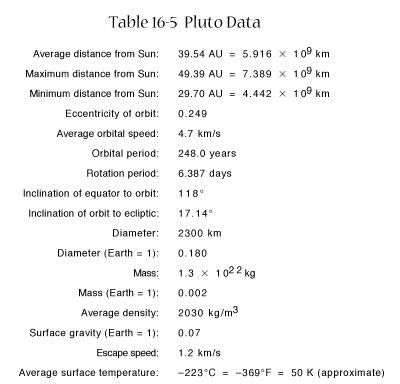
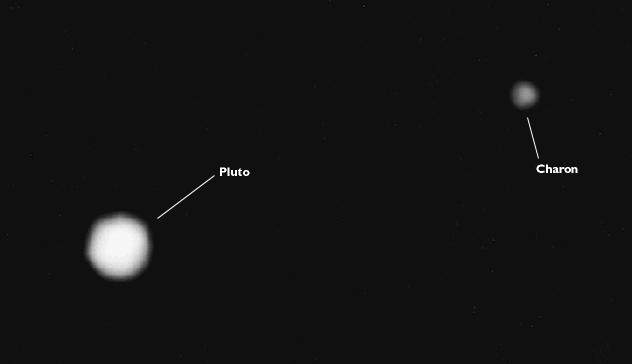
Two
hemispheres of Pluto
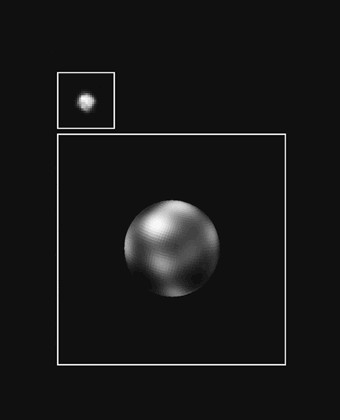
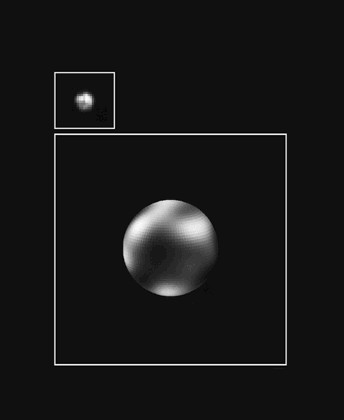
The
Kuiper Belt
-
Originally
proposed by Gerard Kuiper in 1951
-
First
Kuiper belt object seen in 1992 (talk about going out on a limb)
-
Kuiper
belt thought to be a reservoir of chucks of ice that become comets if they
fall toward the sun
-
Disk
shaped, in plane of solar system
-
50
-- 500 AU
-
What
is the asteroid belt's extent
-
2 --
3.5 AU
-
Orbits
in Kuiper Belt are ~200 years
-
orbits
can be disturbed by outer planets
-
as
ice chunck comes toward Sun, becomes a comet (more later)
-
Comets
from the Kuiper Belt (or closer) are short period comets
-
Comet
Halley orbits every 76 years
-
most
(>35,000) just stay out in Kuiper Belt

Oort
Cloud
-
Proposed
by Jan Oort in 1950
-
Oort
cloud objects yet to be see in the Oort cloud
-
See
~ 1 per month in the form of a long period comet
-
periods
of 10,000 to 30 million years!
-
e.g.
Hale-Bopp in 1997
-
Oort
cloud spherical
-
otherwise
long period comets would all be in plane of solar system
-
extends
from 500 AU to 50,000 AU
-
nearest
star is ~250,000 AU
-
Oort
cloud probably icy planetesimals that were ejected during formation of
solar system
-
Probably
billions of objects in Oort cloud
-
The
solar system had a messy childhood
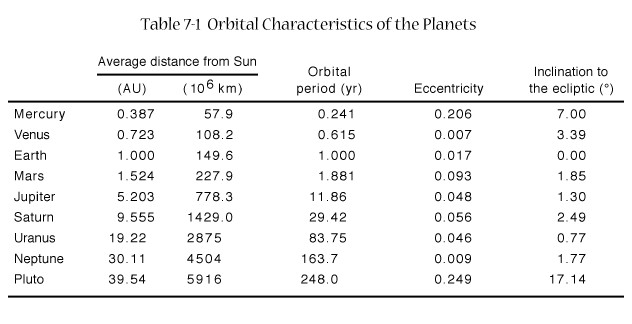
Comets
-
Where
do comets come from?
-
Oort
cloud or Kuiper Belt
-
Are
comets young or old?
-
Very
old
-
Probably
left-over icy planetesimals
-
Comets
are mostly ice
-
What
happens to ice when it is far from the sun?
-
When
ice gets close to the sun it vaporizes
-
Water
vapor (H2O) is broken up by sunlight into oxygen and hydrogen
-
Sunlight
does not push on hydrogen, expands in a ball 10 million km wide
-
is
this what we think of when we see a comet?
-
other
effects give the interesting shapes, colors
-
Does
a comet die when it comes close to the sun?
-
Usually
not: it looses 0.5% to 1% of its mass per orbit
-
Death
sequence described later
Comet
Kohoutek, 1974. Optical light (left) hydrogen UV lines only (right)
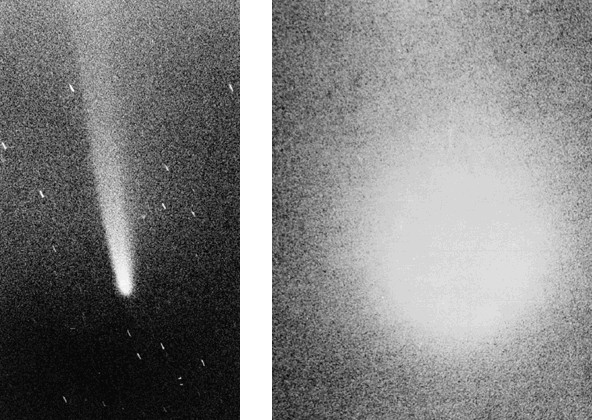
Structure
of a Comet/Comet tail
-
Before
it starts vaporizing, the comet is just a dirty snowball
-
snowball
part becomes nucleus
-
Water
vapor expanding off of nucleus that has not broken into H and O yet forms
coma
-
The
coma is generally what we think of as the "head" of the comet
-
Hard
to see nucleus through coma
-
Generally
see jets of water vapor coming off of nucleus
-
"Dirt"
part of comet flys off with water, becomes dust tail
-
dust
is reflective, light actually pushes on it!
-
radiation
pressure
-
Sunlight
that breaks up H2O also ionizes H2O and other elements
found in comet (e.g. CO)
-
ions
get swept back by solar wind
-
Solar
wind much more effective at pushing ions than radiation pressure is at
pushing dust
-
Two
tails
-
Ion
tail (straight back)
-
Dust
tail (curved)
-
a 3rd
tail was discovered in Hale-Bopp due to a special interaction of sodium
and sunlight, sticks even straighter back than ion tail
-
Production
of water, ions, etc. can vary from day to day, changes affect ion tail
more (moving faster)
-
Comet
tails always point away from the Sun (at least as viewed from above
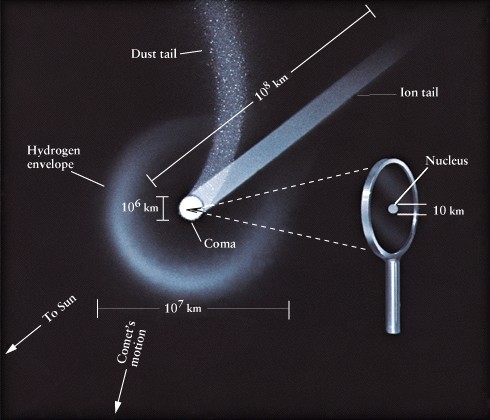
Nucleus
of Comet Halley from Giotto spacecraft
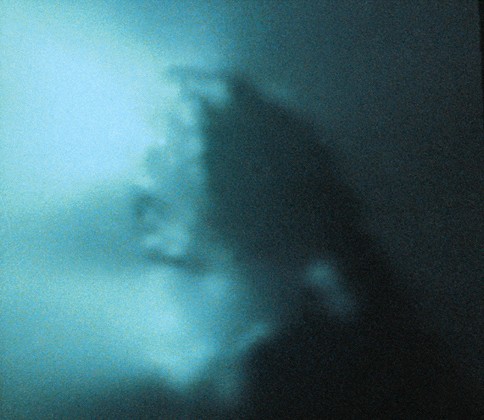
Two
tails of comet Mrkos (1957, two day intervals)

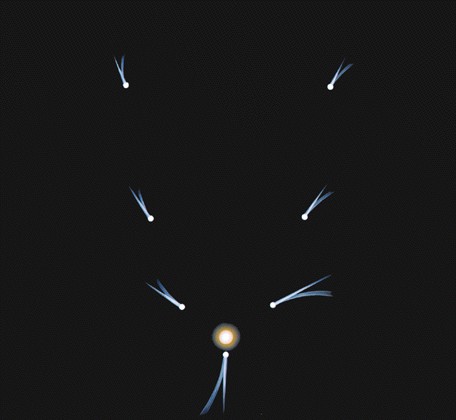
Jeff's
Professional Interest
-
I study
oxygen in comets
-
Like
hydrogen, oxygen should expand out like a ball (nothing pushes on it)
-
However,
we observed something different in comet Hale-Bopp
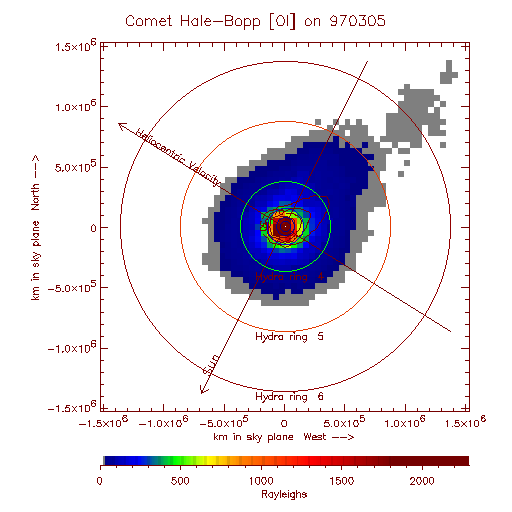
The
Death of Comets
-
Comets
loose 0.5 -- 1% of their material each orbit
-
most
of the material is water, but some dirt left behind too
-
Eventually
the comet hits something like Jupiter
-
Recall
comet Shoemaker-Levy 9
-
OR
the ice that holds the dirt together will completely give out
-
Former
comets become a string of pebbles that continues to orbit the Sun
-
string
of debris eventually spreads out on orbit
-
If
we pass through comet tail debris we see a meteor shower
-
Perseids,
Aug 12 (comet Swift-Tuttle)
-
Leonids
Nov 16 (comet Temple-Tuttle)
-
If
we are lucky, we see hit a dense spot in the tail debris and see a meteor
storm
-
1833
Leonids -- ignited popular interest in astronomy
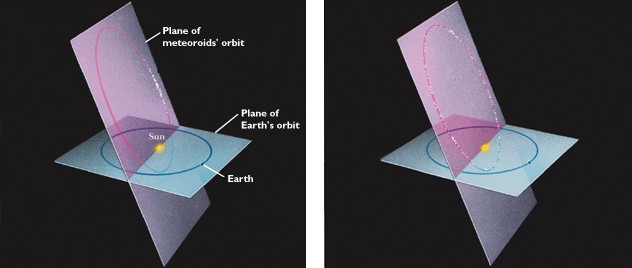
Meteor
showers appear to emanate from a small region on the sky
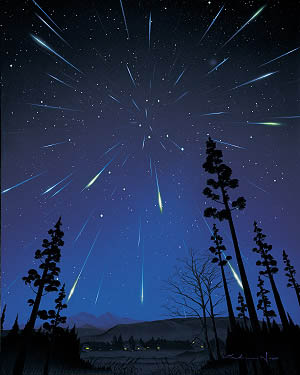
Kuiper
Belt, Oort Cloud and Comets Summary
-
Finish
off Pluto and its moon Charon
-
may
be a Kuiper Belt object
-
Kuiper
Belt
-
similar
to asteroid belt but beyond Pluto
-
source
of short period comets
-
Oort
Cloud
-
Large
spherical cloud of ice chunks centered on Sun
-
source
of long period comets
-
Solar
system length scale review
-
Comets
-
The
death of comets
















